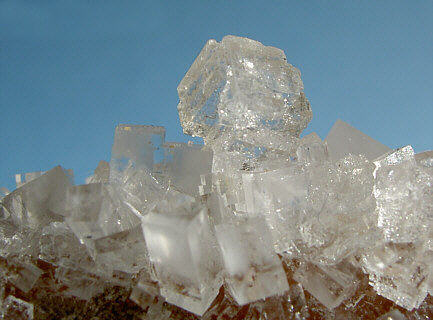Salty saga
An international row over live bacteria from salt ‘millions of years old’ has a lot to teach us

The sensational news: In October 2000, researchers led by Professor Russell Vreeland from Pennsylvania’s West Chester University claimed to have revived bacteria which had lain dormant, trapped within salt crystals since the time they formed.1 Big deal, you might say—but the salt crystals, from a mine in New Mexico, came from 600 m (2,000 ft) below ground, from a layer geologically ‘dated’ at about 250 million years old.
The issue: If the bacteria really did come from within the crystals, and were not from contamination by modern bacteria, then it follows that all of their complex, fragile machinery survived from the time when the geological layer was formed. If that was a few thousand years ago, then such survival becomes remotely feasible, although even this would be astonishing.
Biological molecules are immensely complex, and as such are very fragile. Take DNA for instance. Even if protected from moisture, heat and other forms of energy such as radiation, it will eventually ‘fall apart’.2 In fact, laboratory measurements indicate that after at most 100,000 years, there should be no DNA left, let alone the entire intact machinery which goes to make up a living thing.3
Entombed within a salt crystal, a living thing cannot extract energy from its environment. So the only way it could survive for even hundreds of years in that situation would be to become dormant, i.e. to ‘switch off’ its machinery. However, that would prevent it from being able to repair itself. The tendency for it to fall apart would remain unchecked.
The obvious conclusion: the geological layer is not millions of years old at all. Perhaps realizing this profound implication, many scientists have become very sceptical of such claims, even of ‘ancient’ DNA, let alone ancient life.
The controversy: Professor Dan Graur and Dr Tal Pupko, of Israel’s Tel Aviv University, now claim to have shown that the bacteria revived from salt are actually modern contaminants.4 The basis of their claim is that comparing the genetic (DNA) sequences of the ‘revived’ strain with those of a modern type shows they are very similar. If the difference between them was 250 million years, these researchers say, there would have been many more accumulated genetic changes.
The original researcher has responded strongly. Prof. Vreeland says that although he was asked to review Graur and Pupko’s original paper about the sequences, they would not publish his responses. He insists that the precautions he and his team took were such as to completely exclude contamination, which he says has a less than one in a million chance of having occurred. The team is so certain of this that one of his co-workers suggests that the reason for the similarity may be that these ancient bacteria have previously escaped into the environment, as salt from the deposit was dissolved into a river.
While the controversy rages, one obvious possibility emerges: both sides could be right!
Consider this scenario: Dr Vreeland and his colleagues are correct that the bacteria they revived were indeed trapped within the salt crystal. The critics are correct when they insist that the laws of physics mean that no living thing could remain dormant for more than a few thousand years at most.
Thus: The geological formation is indeed only a few thousand years old, not 250 million. This neatly explains why the revived bacteria are so similar to their modern counterparts—there hasn’t been enough time to accumulate too many mistakes, and things reproduce after their kind anyway. From the Bible, we know that the whole world is only some 6,000 years old, and the deposit containing the salt crystals was almost certainly formed at the time of Noah’s Flood, about 4,300 years ago.
Summary: If the West Chester team truly has done what it claims in eliminating contamination by modern bacteria, the reviving of bacteria from these salt crystals is powerful evidence that the whole geological dating system is way out of kilter. The similarity of the revived bacteria to modern ones, although used to oppose the claim, would then turn out to further confirm that the ‘250-million-year’ belief is a fiction.
References and notes
- Vreeland, R.H., Rosenzweig, W.D., Powers, D.W., Isolation of a 250 million-year-old halotolerant bacterium from a primary salt crystal, Nature 407 (6806):897–900, 2000. We reported on their findings in Creation 23(2):6, 2001. Return to text.
- This is from the random effects of molecular motion, consistent with the Second Law of Thermodynamics. It is also impossible to protect it from natural background radioactivity. Return to text.
- See, for example, Sykes, B., The past comes alive, Nature 352(6334):381–382, 1991. As an evolutionist, Sykes believes that intact DNA in ‘old’ sediments is evidence that the laboratory data (he refers to only 10,000 years for DNA in this article, actually), not the age, must be wrong. (See also Creation 15(2):9, 1993; 14(3):43, 1992.) Return to text.
- Row over ancient bacteria, news.bbc.co.uk, 19 June 2001; reporting on Graur and Pupko’s paper in the J. Mol. Biol. and Evol. Return to text.




Readers’ comments
Comments are automatically closed 14 days after publication.